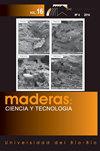Performance of cement-bonded wood particleboards produced using fly ash and spruce planer shavings
IF 1.5
4区 农林科学
Q3 MATERIALS SCIENCE, PAPER & WOOD
引用次数: 2
Abstract
The aim of this research was to investigate the physico-mechanical, thermal, and morphological properties of cement-bonded wood particleboards produced by using fly as has a partial cement replacement and spruce planer shavings. Experimental single-layer cement-bonded wood particleboards produced using a target density of 1200 kg/m 3 , 1/3 wood-cement ratio, a dimension of 460x460x10 mm 3 and 5%, 10%, 15%, 20% fly ash as cement replacement were tested for physical and mechanical properties in accordance with EN and ASTM standards. Moreover, morphological and thermal properties of the cement-bonded wood particleboards were analysed by using the scanning electron microscope and thermogravimetric analysis-derivative thermogravimetry. Test results indicated that the fly ash enhanced both the bending strength and water-re sistance of the cement-bonded wood particleboards. Internal bond and screw withdrawal strengths tended to decrease as the fly ash content increased in the cement-bonded wood particleboards, but this decrease was not statistically significant. As the fly ash increased, the weight loss of the cement-bonded wood particleboards decreased in the thermogravimetric analysis because of the pozzolonic reaction of the fly ash with calcium hydroxide. In the scanning electron microscope, it was observed that calcium silicate hydrate gel increased, whereas calcium hydroxide decreased as the usageratio of the fly ash increased in the cement-bonded wood particleboards.用粉煤灰和云杉刨花生产的水泥粘合木刨花板的性能
本研究的目的是研究使用部分水泥替代品和云杉刨花制成的水泥粘合木刨花板的物理力学、热学和形态学特性。采用目标密度为1200kg /m 3, 1/3木灰比,尺寸为460x460x10mm 3,以5%、10%、15%、20%的粉煤灰作为水泥替代品,按照EN和ASTM标准进行了物理力学性能测试。利用扫描电子显微镜和热重分析-导数热重分析对水泥胶合木刨花板的形貌和热性能进行了分析。试验结果表明,粉煤灰的掺入提高了水泥木刨花板的抗弯强度和抗水性。随着粉煤灰掺入量的增加,水泥胶结木刨花板的内粘结强度和螺杆抗拔强度有降低的趋势,但这种降低趋势无统计学意义。在热重分析中,随着粉煤灰掺量的增加,由于粉煤灰与氢氧化钙的碱溶反应,水泥胶结木刨花板的失重减小。通过扫描电镜观察,随着粉煤灰用量的增加,水合硅酸钙凝胶量增加,而氢氧化钙凝胶量减少。
本文章由计算机程序翻译,如有差异,请以英文原文为准。
求助全文
约1分钟内获得全文
求助全文
来源期刊

Maderas-ciencia Y Tecnologia
工程技术-材料科学:纸与木材
CiteScore
2.60
自引率
13.30%
发文量
33
审稿时长
>12 weeks
期刊介绍:
Maderas-Cienc Tecnol publishes inedits and original research articles in Spanish and English. The contributions for their publication should be unpublished and the journal is reserved all the rights of reproduction of the content of the same ones. All the articles are subjected to evaluation to the Publishing Committee or external consultants. At least two reviewers under double blind system. Previous acceptance of the Publishing Committee, summaries of thesis of Magíster and Doctorate are also published, technical opinions, revision of books and reports of congresses, related with the Science and the Technology of the Wood. The journal have not articles processing and submission charges.
 求助内容:
求助内容: 应助结果提醒方式:
应助结果提醒方式:


